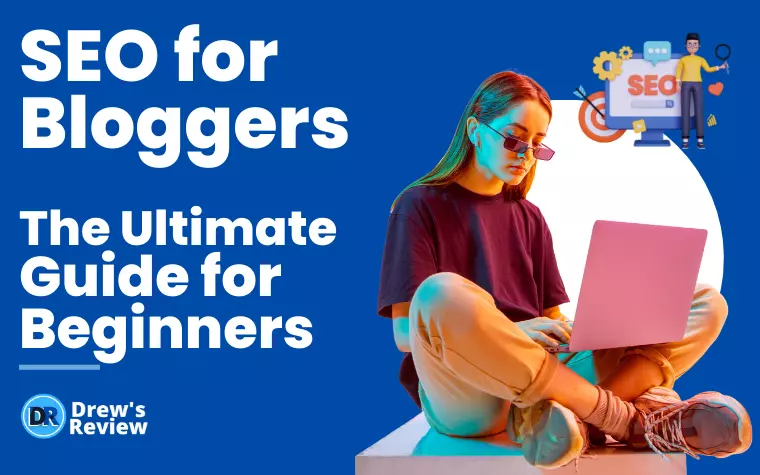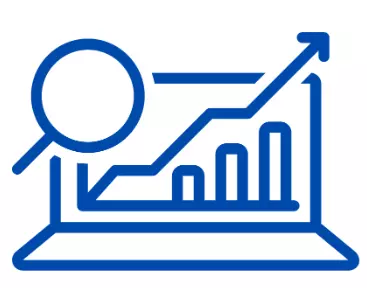
New to blogging? Did you know that bloggers focus most exclusively on traffic from the search engines?
A lot of people don't start blogs because they think SEO is difficult. The truth is, it's really not if you have the knowledge.
In this article on SEO for bloggers, I am going to tell you why you need to do SEO and then list 15 ways on how to accomplish it so your blog ranks on page one.
Why Is Blog SEO Important?
As someone who owns a blog, you likely already know that SEO is important. After all, SEO. which stands for search engine optimization, is what helps your blog show up in search engine results pages (SERPs).

And if you're not on the first page of the SERPs, you're missing out on a lot of potential traffic. But why is SEO so important?
Well, for one thing, it can help you reach a wider audience. People who are searching for the keywords that you're targeting are more likely to find your blog if it's well-optimized.
Additionally, SEO can help to build trust and credibility with potential readers. If your blog appears in the top results for relevant searches, people will be more likely to view it as a reliable source of information.
Finally, good SEO can also lead to increased engagement from your readers. If people are able to find your blog easily and navigate it without any issues, they're more likely to stick around and read your content.
How Does Google Work? in Regards to SEO?
In order to understand how Google works in regards to SEO, it's important to understand a little bit about how Google ranks websites.
When someone types in a query, Google uses a complex algorithm to determine which websites should appear in the search results. This algorithm takes into account a variety of factors, including the quality of the website's content, the number of other websites linking to it, and the keywords that are used on the website.
In order for a website to rank well on Google, it needs to have high-quality content that is relevant to the user's query, and it also needs to be properly optimized for Google's algorithm.
While there is no one-size-fits-all formula for success with Google, following these basic principles will help your website rank higher in the search results.
SEO for Bloggers: 15 Crucial Steps You Must Take
As a blogger, here are some SEO strategies you can take to increase your rankings.
1. Optimize Your Blog Post Title and Subheadings
The title and subheading are the most important parts of your blog post because they tell the reader what your article is about. If you don’t write compelling headlines and subheads, people won’t read your articles. In fact, some studies show that readers spend less than half a second reading the headline and subheading of an article.
Your title should include your main keyword phrase. This helps your audience find your article easily. You can use headings to break up long paragraphs. They help make each section easier to digest.
Meta descriptions are short lines of text that appear under your article’s title in search engines like Google. These descriptions give visitors a quick summary of what your article is about, making it easy to decide whether they want to read it.
You can add multiple keywords to your title and meta description. But try to keep them natural. Avoid stuffing words into your headlines and descriptions. Instead, choose terms that describe your topic clearly and concisely.
2. Write Content That Brings Value
Focus on creating great content rather that producing lots of content. Content marketing is about providing information, education and entertainment to people. If you produce lots of content without adding value to it, no one will want to read it.
The type of content you write needs to add value. This doesn’t mean that you shouldn’t provide information; however, make sure that you do it in such a way that makes sense to your target audience.

For example, if you run a blog about gardening, you could write articles on how to grow vegetables in containers, how to use compost tea to fertilize plants, etc.
Don't focus your entire blog on content that just sells. In other words, pages like reviews, product comparisons or "best of" type pages that clearly include affiliate links should be about 30% of your total content. You can still sprinkle affiliate links within your helpful content, but just make sure you strike a balance between info posts and promotional posts with info being greater of the two.
Each piece of content should also be unique. Don't write about the same thing in various posts. Don't let your posts get stale either. Update your posts with fresh content at least once or twice a year. Updating content has shown to get a boost in SEO ranking as well.
I shouldn't have to say it, but as you know, avoid keyword stuffing at all costs. Don't repeat your target keyword over and over in your article either. Mentioning it just a few times is fine. The secret is to write naturally.
3. Build Relationships With Influencers In Your Niche
Influencer Marketing is a powerful tool for brands looking to reach audiences beyond the traditional media. By partnering with influencers, brands are able to connect directly with consumers, bypassing the gatekeepers of mainstream media.
Contact influencers that have a social presence online. See if you can have a mutually beneficial exchange. Perhaps you have something to offer them? In return, they could mention your blog or link to it which is great for SEO.
4. Optimize Meta Descriptions and URLs
Meta descriptions are important for SEO reasons, especially if you want your site to rank well in the search engines. They help people decide whether it’s worth clicking on your link and reading your content. A meta description is usually displayed alongside the URL in the browser address bar. You can use up to 160 characters for each one.
Write good meta descriptions because they are useful for increasing traffic and conversions. Include relevant keywords in your meta description and make sure they match the keyword(s) used in the URL. If possible, try to keep your meta description short and sweet.
Your meta description shouldn't be "clickbaity", but at the same time it should be written to entice people to click. The more clicks you have vs impressions, the better it is for blog SEO.
5. Ensure Your Site Is Mobile Optimized
Google’s algorithm update rolled out in April 2018 included a change to how it ranks sites based on mobile friendliness. A study conducted by Moz found that mobile-friendliness scores dropped by nearly 20% following the update.
In addition, Google announced that it would begin penalizing sites that fail to meet certain standards. The company stated that it wants to make sure that people are able to easily access information on mobile devices.
The most important thing you can do to improve your mobile rankings is to optimize your site for mobile. This includes making sure your site loads quickly, ensuring you use responsive web design, and testing your site speed.

A great way to test whether your site is mobile friendly is to load up your desktop browser and view your site via a smartphone or tablet. If everything looks good, try loading it up again while viewing it on a phone or tablet.
If there are issues, such as long loading times or slow scrolling, you may want to consider redesigning your site to accommodate mobile visitors.
6. Improve Your WordPress Webpage Speed
WordPress is one of the most popular platforms for building websites today. However, it doesn't come without some drawbacks. One of those is slow load times.
There are many ways to speed up WordPress. Some require technical knowledge while others don't. We'll go over both options here. To determine if your site is slow apart from just watching it load, there are tools you can use such as Google's Page Speed Insights or GTMetrix. You should also connect Google's Search Console to see if you are passing Core Web Vitals.
Here are some ways to increase page speed:
Remove Unnecessary Plugins
Plugins add functionality to your site. But, sometimes they do more harm than good. If you're not sure whether a particular plugin is necessary, you can either talk to your host, your theme support (if you have upgraded to a paid plan that included support) or a trusted colleague that might have a better understanding than you.
Optimize Images, CSS & JS Files
Images, CSS, and Javascript take up a lot of space on your server. So, make sure you compress them properly. I like to compress them using an online compress tool that converts it to Webp. Just do a Google search for JPG to Webp or if your image is png, then search for png to webp. You can also add a plugin that does this automatically, but then you are just adding another unneccesary plugin!
Use a Caching Plugin
Caching plugins store static data like images, videos, and other media so that they don't need to be loaded from the server every time someone visits your site. It's an easy way to speed things up. There are plenty of free caching plugins but the one I use is WP-Rocket. It's a paid plugin but it's the best out there.
USE a CDN (Content Delivery Network)

CDNs allow you to host all of your website assets, including images, videos, and JavaScript files, on a third party server instead of your own.
They also provide a faster connection between your visitor and your content.
The most popular CDN is Cloudflare, which I use on all my sites. It's free to use and you really don't need to upgrade to the paid plan.
Use a Responsive Design Template
Responsive design templates automatically adjust to fit whatever screen size is being used. This ensures that your website always looks its best regardless of the device being used.
Change Host
Your problem might not be on your end. You could have everything right but your site is still slow. The problem likely is with your host. You can find out for sure by doing a speed test on Google's Page Speed Insights. It will let you know if there's a potential server side issue.
Hire a Professional
If you've got a great host, you've exhausted all opportunities and it's still either failing a speed test on Page Speed Insights or GTMetrix, it's time to have a pro look at it. You can find plenty of help on Fiverr. It shouldn't cost you more than $50 to get the problem fixed which is a bargain. There are other services out there, but expect to pay more.
7. Linking to Content Within Your Own Site
Linking to other sites using external links helps build authoritativeness and trust within your niche, and linking to content within your own content increases its authority. If you want to do it manually, there are many ways to go about it.
The easiest way is to just do a search (using your search box on your site) and just search for a keyword that best describes the page you want to internal link to.
There should be one or a few articles that show up. In each, link to the target page with a keyword that makes sense.

Or, you could just pull up the articles that are all relative to one another and link them together.
To make it real easy, you could use a tool called "LinkWhisperer," which allows you to automatically do internal linking with little effort.
8. Add Visuals
Adding images and videos to your blog posts will help them rank well in the search engines. This includes adding ALT tags to your images and videos.
- Here are some tips to make it easier to add images and videos to your post.
- Use free image hosting sites like Imgur, Flickr, and Pexels. These allow you to upload high quality images without having to pay for storage space. You can even use the same account across multiple platforms.
- Upload images directly into WordPress using the media library.
- Create custom fields for each type of image you want to include. For example, if you wanted to add a photo of yourself, you could create a field called "Photo". Then, when you're creating your post, just select the appropriate field and upload the photo.
- If you're uploading photos from another site, make sure to check the copyright information. Some sites don't give permission to re-use images.
- When choosing an image, ensure that it closely relates to your subject matter.
- Don't forget about video. Videos are great because they provide context and insight into your subject matter. They also increase the likelihood that someone will link to your article. Videos can be embedded from YouTube. Just look for the embed code in the share section below each video.
9. Keep an Eye on Your Blog’s Analytics
If you're running a blog, it's important to keep an eye on your analytics. This way, you know what works and what doesn't work well for your audience. You'll notice certain posts perform better than others, and you can make adjustments accordingly.

Analytics are often overlooked because they require some technical knowledge to set up properly.
However, there are plenty of free tools out there that help you monitor your traffic and conversions. I would just stick with Google Analytics.
If you don't already use Google Analytics, you should start now. It's one of the most popular tracking platforms online today, and it's free. With Google Analytics, you'll see everything about your visitors' behavior, including where they came from, how long they stayed on your site, and how much money they spent while browsing.
Get a Keyword Tracker Tool
This is going to be a paid option for most tools but some have a free plan. There's tons out there and they all do pretty much the same thing. Just do a search for "keyword tracker". When you use a keyword tracker, you'll be able to see what position you are ranking for with a given keyword.
Ensure that you get the best keyword tools by checking out software review websites such as Truely. It lets you compare various keyword tools that you can use for your blog and gives you honest reviews from users to help you make your choice.
This really helps because you can track your progress. If a keyword is stuck on page two for example, then you know you need to improve your content or possibly build backlinks to it.
10. Build Quality Links
Backlinks to your website are important. They're one of the most powerful tools in SEO. But how do you get backlinks also known as inbound links?
If you're new, the best thing is to start with all your social profiles which will allow you to link directly to your blog.
After that, you can get links using HARO, which is free. HARO stands for "help a reporter out" and you simply answer a question that you might be an expert in.
If they use your content (usually between 100-200 words) then you'll get a link back to your blog.
The next option is using outreach. There are outreach services that you have to pay for but you can do this manually. Just look for other websites in your niche and ask if they accept guest articles. If they do, then you can write an article for them and include a link back to your site.
Don't do BlackHat SEO
BlackHat SEO is using things like PBN's which stand for private blog network. These are sites that are usually low quality that are built for one purpose - to link to other sites.
Stay away from these. Another thing to stay away from is SEO backlinking services. There's plenty of these guys on Fiverr. While I think Fiverr is great, don't ever use it for SEO.
11. Look at the Intent
The most important thing to remember when writing content is to look at the intent of the keyword you're targeting. The best way to accomplish this is to enter a keyword in Google. Look at all the pages ranking on the first page.
What are they about? Pay attention to the titles and content. Write similar, relevant content but don't copy. Understand the message and how it aligns with your keyword. Done!
That's how you match user intent and gives you a better chance to rank. It also gives you a chance to get the featured snippet which is the position just above number 1. This technically is the number one spot because it's the first result on page 1 of Google.
12. Stick With Wordpress
There are numerous CMS options out there, but just stick with Wordpress. According to Kinsta, Wordpress accounts for 43% of all websites on the internet. That's almost half of the entire internet.
WordPress is not only easy to use, but very SEO friendly. In Blogging SEO, there's no reason not to go with WordPress.
Apart from that it's very customizable, safe and secure, and free to use. Sure there are paid options such as upgradable themes, but at it's core it's free to use.

13. Improve Your Bounce Rate
Bounce rate is the percentage of users that will leave your site after they view one of your pages.
If the bounce rate is too high, it tells Google that people either didn't find the info they were looking for, your page is ugly, or the content just wasn't up to snuff. Either way, be sure to connect Google Analytics so that you can see what your bounce rate is.
Make changes to pages that have a high bounce rate and it will improve your SEO.
14. Start Off With Longtail Keywords
Longtail keywords are keywords that have a lower search volume, but are easier to rank for. If you're a new blogger, you should focus on longtail keywords first.
Since it's easier to rank this way, you'll not only get more confident with seeing your pages on the SERP's, but it will be easier to rank for harder terms later on.
Summing This All Up
So there you have it. Here are 14 ways to do SEO for bloggers.
As you can see, all of this can be done by yourself and you don't need to hire anyone most of the time.
Following these steps will give you a better chance to succeed in blogging SEO than your competitors that don't have an SEO plan.
Have other ideas or questions? Comment below.
- Best Ways to Make Passive Income on YouTube - April 15, 2024
- How I Make Faceless YouTube Channels With AI - April 9, 2024
- Top 21 Faceless YouTube Niches to Earn Big Profits in 2024 - April 3, 2024
